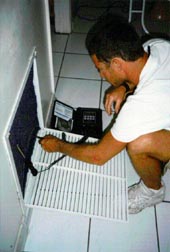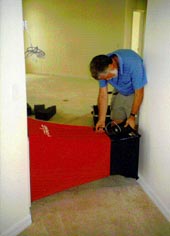
![]()
Air Conditioner Performance Testing

To perform the tests, we developed a procedure that can be used to measure the instantaneous efficiency of a cooling system. The procedure is entirely based on physical measurements. First the dry coil air flow is determined by turning on the heat pump back-up resistance heat elements and measuring the temperature rise across the heating coil. We used a portable Cooper Instrument Corp. (Middlefield, CT) SH66A multi-probe digital thermometer to take this measurement. By simultaneously measuring the element wattage (we turned off all non-AC breakers and measured this using the utility meter), the air flow cfm can be gauged through knowledge of air's specific heat and density. As a check, we used a Shortridge flow hood to verify the estimate obtained by the resistance heat method (one hint for anyone doing this: make sure that the thermometer after the coil is around the first bend in the duct work, or at the first register, or you will risk poorly mixed air in the air stream after the coil).
Secondly, the air conditioner is turned on to cooling and the temperature drop across the coil is measured. Within the tests, we used two temperature probes before and after the coil. One set of the probes recorded the dry bulb temperature. During cooling operation, the other two probes had saturated cotton shoe-laces inserted into the air stream to measure the wet bulb temperatures before and after the coil. This would allow determination of the coil latent performance by looking at the change in enthalpy across the evaporator coil. As a check on this measurement, we also collected air conditioner condensate over a ten minute period once flow had begun. Finally, an outdoor temperature is taken at the condenser inlet since the rated EER of units is typically based on this condition and that indoors. The entire procedure is described in detail here. An automated procedure for calculation on the Web is here. The product of the change in enthalpy across the evaporator coil times the measured air flow yields the total cooling. By measuring the power demand of the AC system, the system energy efficiency ratio (EER) is obtained.

The test at the PVRES home was done with the variable speed air handler (VSAH) operating at full speed. The unit was configured with the VSAH operating such that much of the time it operates at less than half speed. (For each cooling cycle, the unit operates at 50% flow for the first minute, then 80% flow for the next 7.5 minutes and finally 100% after that if necessary). Our experience so far shows that the unit seldom operates at full speed since measured on cycles last about six minutes.) Still we wanted to evaluate the unit operating at maximum speed where sensible heat gain would be at its highest and latent heat removal at its worst (a notorious problem in Central Florida). Readers may recall that we designed the duct system to have low resistance to flow. At full speed, we measured an air flow of 1380 cfm. The unit was operated in this mode for 20 minutes before measurements were taken; the outdoor inlet air temperature was 87°F. A 12.9 degree temperature drop was measured across the coil (Treturn = 70° [62° W.B.], Tsupply =57.1° [56° W.B.]) with a sensible cooling rate of 18,530 Btu/hr. Even at the high flow rate, latent performance was quite good with 8,770 Btu/hr of moisture removed. Total capacity was 27,300 Btu/hr with measured power at 2074 Watts-- an overall EER of 13.2 Btu/W. The nominal SEER of the specific unit is 14.5 Btu/W. The rated capacity of the unit at the closest rated condition (85oF outdoor dry bulb, 72°F entering dry bulb, 63°F wet bulb) was 25,200 Btu at 900 cfm with an EER of 14.1 Btu/W. Given the higher outdoor temperature, the unit was very close to its rated efficiency.
